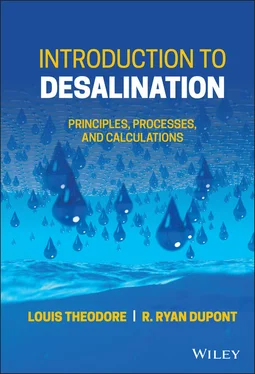1 ...7 8 9 11 12 13 ...24 Absolute pressure gauge – A device that measures the pressure exerted by a fluid relative to a perfect vacuum.
Absolute scale – A temperature scale that is based on absolute zero and that uses units of measurement equivalent to Centigrade degrees on the Kelvin scale or to Fahrenheit degrees on the Rankine scale.
Absolute temperature – The temperature expressed in degrees Kelvin (K) or degrees Rankine (°R).
Absolute temperature scale – A scale (e.g. Kelvin, Rankine) in which temperatures are measured relative to absolute zero.
Absolute vacuum – A void that is completely empty of matter.
Absolute zero temperature – The temperature of zero degrees on either the Kelvin or Rankine scale at which molecular motion is thought to cease.
Absorbate – A substance that is taken up and retained by an absorbent.
Absorbent – Any substance that takes in or absorbs other substances.
Absorber – A device in which a gas is absorbed by contact with a liquid.
Absorption – The process in which one material (the absorbent) takes up and retains another (the absorbate) to form a homogenous solution; it often involves the use of a liquid to remove certain gas components from a gaseous mixture.
Absorption tower – A vertical tube or pipe in which a rising gas is partially absorbed by a liquid, usually in the form of falling droplets.
Acid – A material containing hydrogen that produces at least one hydrogen ion when dissolved in a water solution; it can react with and neutralize a base to form a salt.
Acre-foot – A measure of volume; 43,560 cubic feet, 325,900 gallons, or the volume of water covering 1 acre, 1 foot deep.
Action level – The level of a contaminant that, if exceeded, triggers treatment or other requirements that a water system must follow.
Acute health effect – An immediate effect (i.e. within seconds, minutes, hours, or days) that may result from exposure to certain drinking water contaminants (e.g. pathogens).
Adiabatic – A term used to describe a system in which no gain or loss of heat occurs.
Adjudication – A process performed by the courts that determines ownership of groundwater and assigns a Watermaster to manage or enforce pumping rights and sometimes water quality; this is often a multiyear process.
Advanced wastewater treatment – Any process that is employed for the treatment of wastewater that follows secondary treatment and serves to improve the quality of effluent prior to reuse or discharge; this may include the removal of phosphorus, nitrogen, suspended solids, dissolved organic compounds, dissolved solids, etc.
Aerobic – A term used to describe a system that requires oxygen to sustain itself.
Agricultural irrigation – Water distribution systems and practices in agriculture.
Air stripping tower – A tower used to remove volatile organic chemicals (such as solvents) from contaminated water by causing them to evaporate; polluted water is sprayed downward through a tower filled with packing materials while air is blown upward through the tower.
Algae – A large group of aquatic plants that contain chlorophyll; they vary from a single cell to multicellular organisms; algae exist in saltwater and freshwater, and can adversely affect water quality when excessive growth and death occurs (eutrophication), resulting in the lowering of the oxygen content in water.
Algae bloom – A sudden proliferation of algae in water bodies, usually stimulated by the excessive input of nutrients (e.g. nitrogen and phosphorous); this can adversely affect water quality by causing a lowering of the oxygen content in the water.
Ambient – A term used to describe the surrounding area or environment.
Anaerobic – A chemical/biochemical reaction, process, or microorganism that occurs in the absence of oxygen.
Appropriative water rights – Holders can use available water that is not taken by anyone else.
Aquatic – A term used to describe any organism growing in, living in, or frequenting water.
Aquatic growth – Any floating, drifting, or attached organism in a body of water.
Aqueduct – A conduit or channel employed to convey water from one location to another.
Aqueous solution – A solution with water as the liquid phase.
Aquifer – A geologic formation, group of formations, or part of a formation that is capable of yielding a significant amount of groundwater to wells or springs.
Artesian well – A well tapping a confined aquifer in which the static water level is above the bottom of the upper confining unit; a flowing artesian well is a well in which the water level is above the land surface.
Audit – The examination of something with the intent to check, verify, or inspect.
Available oxygen – The quantity of dissolved oxygen available for oxidation of organic matter in a water body.
Backwash – Water used in a filtration system to separate clogging material from a filter media to clean the filter so it may be put back into service.
Backflow – A flow condition induced by a differential in pressure that causes the flow of water or other fluid into the distribution pipes of a reservoir from any source other than its intended primary source.
Base – Any compound that dissociates in aqueous solution to yield hydroxyl ions; it is employed to neutralize acids.
Batch process – An unsteady-state process that is not continuous; its operations are carried out with discrete quantities of material.
Bedrock – The solid rock mass located below the loose material on the Earth’s crust such as soil, glacial drift, or alluvium.
Biota – All of the living organisms that exist in an area.
Blackwater – A water that contains human wastes.
Blowdown – The cyclic or constant removal of a portion of any process flow to maintain the constituents of the flow at a desired level.
Boiler feedwater – The water fed into a boiler to replace that evaporated in the generation of steam.
Boiling point – The temperature of a liquid at which its vapor pressure is equal to that of the atmospheric pressure of the environment; it is 100°C (212°F) for water at sea level.
Bound water – The water molecules that are tightly held by various chemical groups in a larger molecule.
Brackish water – A water with a salt content in the range between that of freshwater and seawater.
Brine – A concentrated solution of salt and water that remains after the removal of a distilled product.
By-pass – The avoiding of a particular portion of a process or system.
By-product – A material that is not one of the primary products and is not solely or separately produced by the production process.
Calibration – The determination, checking, or adjustment of the accuracy of any instrument that gives quantitative measurements.
Carcinogen – Any substance that can cause cancer.
Carryover – The entrainment of liquid or solid particles in the vapor evolved by a boiling liquid or from a process unit.
Catch basin – A chamber or well, usually built at the curbline of a street, that admits surface water for discharge into a storm water drain.
Chemical analysis – The analysis by chemical methods that provides the composition and concentration of a substance.
Chemical sludge – The sludge obtained by treatment of wastewater with chemicals.
Chemical treatment – Any one of a variety of technologies that use chemicals or a variety of chemical processes to treat a system or waste.
Chlorine demand – The amount of chlorine necessary to produce a free chlorine residual in a water sample.
Chlorine water – A clear, yellowish liquid that degrades on exposure to air and light; it is employed as a deodorizer, disinfectant, and antiseptic.
Читать дальше












